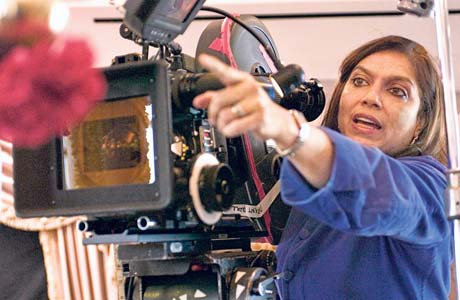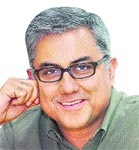|
| SIXTH ANNUAL IAAC FILM FESTIVAL: NOV 1-5, 2006 |
| Reviews |
| |
Casting The Namesake
Sunday, November 05, 2006 | Views |
 Nair's struggle in casting in The Namesake has been well documented in the press
Nair's struggle in casting in The Namesake has been well documented in the press |
Mira Nair credits a casting angel for finding her the actors for her newest film
Aseem Chhabra
|
After travelling with The Namesake to Telluride, Toronto, Rome and London, Mira Nair finally brought her latest film to New York City, albeit only for one night. New York is the home to The Namesake. Nair’s film is set here as is part of Pulitzer Prize winner Jhumpa Lahiri’s novel — the source for the movie. And both Nair and Lahiri make their home in New York.
And so earlier this week New Yorkers, especially South Asians, turned up in large numbers for the sold out, $100 ticket, opening show of the Indo American Arts Council’s sixth annual film festival at the AMC Lincoln Square. The opening night screening of The Namesake was packed with celebrities — regular supporters of IAAC events and some surprise guests.
The roster of names included Nair, her husband and Columbia University professor Mahmood Mamdani; Kal Penn, who plays the lead Gogol in the film; Salman Rushdie and wife Padma Lakshmi; Madhur Jaffrey, her husband Sanford Allen, and daughter Sakina Jaffrey; Sarita Choudhury, who launched her film career with Nair’s Mississippi Masala; Shashi Tharoor; singer Asha Puthli; and two recent literary awardees — Turkish author Orhan Pamuk and Kiran Desai.
Missing from the group was Lahiri, who had a previous engagement. Shabana Azmi and Javed Akhtar were supposed to be at the screening. Instead they arrived in New York a day later.
“We are still in our puberty stage,” said Aroon Shivdasani, the executive director of IAAC as she opened the festival. “This is our sixth year, but we have grown by leaps and bound.”
Shivdasani recalled the first festival, held a few weeks after the Sept 11 tragedy. That year the festival screened 12 feature films. This year’s programme includes over 60 features, documentaries, shorts and animation films.
Before the screening of The Namesake, Nair was introduced to the audience by Rushdie. “I don’t think there is a better director than Mira to have directed this movie,” Rushdie said.
Nair followed Rushdie’s warm introduction by taking us back to a few years ago when her mother-in-law suddenly died in New York, after a botched hospital stay. “We buried her in New Jersey on a cold Siberian winter day,” Nair said. Soon after, Nair headed to India to shoot the closing scenes of Vanity Fair, her adaptation of William Thackeray’s classic novel. In the plane, Nair read Lahiri’s The Namesake. “The book captured the mood I was in,” she said.
Nair’s struggle in casting in The Namesake has been well documented in the press. At different times the director sought Abhishek Bachchan, Rani Mukherjee and Konkana Sen Sharma for the film. She eventually settled for Tabu to play the role of Ashima. And for the role of Gogol — after Bachchan rejected Nair’s offer — the director chose the Indian American actor Kal Penn.
“An angel of casting flew over me,” Nair said as she narrated the story of when her son Zohran and his friend Sam Walker took her to a computer screen. On the screen, the two teenagers were watching Penn’s hilarious 2004 film — Harold and Kumar Go To White Castle.
And somewhere in Los Angeles, Nair’s angel of casting had made a connection with Penn. The actor told the audience how he was moved and inspired with Lahiri’s book. And when Penn tried to buy the rights to Lahiri’s book, he was told that Nair had already beaten him to it.
So Penn started a campaign of trying to get an audition with Nair. “He wrote to me a moving letter about how he saw Mississippi Masala in a theatre in New Jersey at the age of eight,” Nair said, adding that Penn was inspired to become an actor by looking at the characters in the film.
“I could get through watching Harold and Kumar… only once,” she said. “But Kal auditioned for me and knocked my socks off.”
|
 Aseem Chhabra is a freelance writer based in New York who has previously written for the New York Times, The Boston Globe, Philadelphia Inquirer and Time Out, New York Aseem Chhabra is a freelance writer based in New York who has previously written for the New York Times, The Boston Globe, Philadelphia Inquirer and Time Out, New York |
| |
|
| |
|

